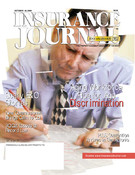U.S. property/casualty insurers recently received good news from the Insurance Services Office Inc.’s (ISO) Property Claim Services (PCS) unit. Third-quarter insured catastrophe losses registered at $315 million—the lowest amount in 11 years beginning in 1990.
“We have been very fortunate—especially residents living along the coastal areas of the country—that Mother Nature has spared us the kind of devastation which usually happens,” said ISO spokesman Dave Dasgupta. “Compare the losses with what they have been in the past years and not only has it meant less damage and destruction for homeowners and business owners…but also for the [insurance] industry itself.”
ISO’s PCS unit defines a catastrophe as an event that causes $25 million or more in insured property losses and affects a significant number of p/c policyholders and insurers. “PCS generally considers cat season based on what meteorologists say—from June through mid-November,” Dasgupta said. “So the season is coming to an end.”
The PCS estimate represents anticipated insured loss on an industrywide basis arising from catastrophes, reflecting the total net insurance payment for personal and commercial property lines of insurance covering fixed property, personal property, vehicles, boats, related property items, business interruption and additional living expenses. The estimates do not include loss-adjustment expenses.
Last year marked the first year in a quarter of a century that California did not suffer a single catastrophe, while Florida, which has incurred the greatest insured catastrophe losses in the last decade, was only tenth, despite 1999’s active hurricane season.
The highest ever third-quarter catastrophe losses were the $17.4-billion losses in third-quarter 1992, largely from Hurricanes Andrew and Iniki. Hurricane Andrew alone caused $16.5 billion in losses throughout the state of Florida. In comparison, the Northridge earthquake in 1994 caused $14 billion in losses in Southern California and pushed the year’s first-half total losses to $15.6 billion.
Twelve states were affected by the three catastrophic events in this year’s third quarter with the worst loss totaling $150 million from a thunderstorm-related event in early July. “The Midwest suffered the most,” Dasgupta said.
The five states that sustained most of the losses in the quarter are: Minnesota ($105 million); Wisconsin ($50 million); Ohio ($45 million); Michigan ($40 million); and Illinois ($16 million).
For the first nine months of 2000, insurers received more than 1.2 million claims for personal and commercial property losses and automobile losses. During the first nine months of 1999, insurers received double that amount—or 2.4 million claims. Meanwhile, insurers’ catastrophe losses through the first nine months of 2000 totaled $3.48 billion, down from $8.06 billion in nine-months 1999.
Looking back on third-quarter catastrophic activities since 1990, this year ranks eighth in total losses, ninth in number of claims and last in number of catastrophes.
“If the fourth quarter turns out to be even lower, or if there is nothing significantly striking in fourth-quarter losses, than overall for this particular year the industry would seem to come out relatively unscathed as far as catastrophe losses are concerned,” Dasgupta said. Fourth-quarter results will be out in early January 2001.
In early August, William Gray, one of the top hurricane forecasters in the U.S., along with his group at Colorado State, predicted that the 2000 Atlantic Basin hurricane season (June 1 – Nov. 30) would bring 11 named storms, with seven growing into hurricanes and three becoming “major” hurricanes. So far there have been 14 named storms with eight growing into hurricanes, and three becoming major hurricanes.
Topics Catastrophe Profit Loss Hurricane Property
Was this article valuable?
Here are more articles you may enjoy.


 BlackSuit Cybercrime Gang Blamed in CDK Hack That Roiled Car Dealers
BlackSuit Cybercrime Gang Blamed in CDK Hack That Roiled Car Dealers  German Insurtech Wefox to Replace CEO After Board Rejects Mubadala Sales Plan
German Insurtech Wefox to Replace CEO After Board Rejects Mubadala Sales Plan  Ford Recalls 668,000 2014 F-150 Pickup Trucks Over Transmission Issue
Ford Recalls 668,000 2014 F-150 Pickup Trucks Over Transmission Issue  Big ‘I’ Report: Independent Agency Channel Placed 62% of Premiums in 2023
Big ‘I’ Report: Independent Agency Channel Placed 62% of Premiums in 2023 


